
Work. Play. Renew.
Forest Creatures and Critters: Guide to Oregon Wildlife
There are over 30 million acres of forestland found in Oregon, making up 11 national forests, six state forests, 361 state parks and numerous other privately and publicly owned forest properties. Oregon’s woods are filled with an abundance of native trees and plant life, creating the perfect habitat for the many different creatures and critters that call Oregon home.
What kind of Oregon wildlife is found around here? Here are eight animals that call Oregon forests their home.
1. American Black Bear
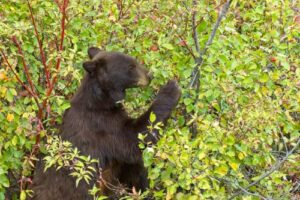 The American black bear is quite common in Oregon and can be found throughout the state. Males can weigh as much as 300 pounds and stand at 3 feet tall, and females can weigh between 150 and 250 pounds and stand between 2 and 3 feet tall. They are omnivores that eat plants, fruits, nuts, insects, honey, salmon and small mammals. They live within forested areas and make their dens in hollow logs or large stumps.
The American black bear is quite common in Oregon and can be found throughout the state. Males can weigh as much as 300 pounds and stand at 3 feet tall, and females can weigh between 150 and 250 pounds and stand between 2 and 3 feet tall. They are omnivores that eat plants, fruits, nuts, insects, honey, salmon and small mammals. They live within forested areas and make their dens in hollow logs or large stumps.
2. Northern Spotted Owl
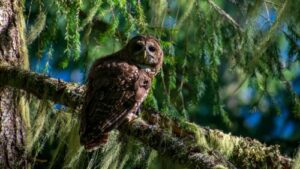 You can find the northern spotted owl in the coniferous forests of the West and East Cascades, Coast Range, Willamette Valley and Klamath Mountains. They are the largest owl species in North America. They are about 19 inches tall and are primarily nocturnal hunters. Occasionally, they will eat bats or other owls, but they mostly eat woodrats and flying squirrels. They live in broken-top trees, tree cavities or nests originally built by squirrels or other raptors. These dwellings can be as high as 200 feet from the ground.
You can find the northern spotted owl in the coniferous forests of the West and East Cascades, Coast Range, Willamette Valley and Klamath Mountains. They are the largest owl species in North America. They are about 19 inches tall and are primarily nocturnal hunters. Occasionally, they will eat bats or other owls, but they mostly eat woodrats and flying squirrels. They live in broken-top trees, tree cavities or nests originally built by squirrels or other raptors. These dwellings can be as high as 200 feet from the ground.
3. Roosevelt Elk
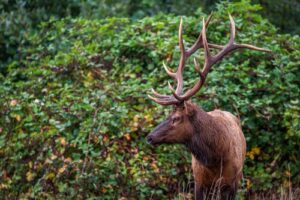 The Roosevelt elk can be found in the Coast Range, West Cascades, Willamette Valley and Klamath Mountains. They are about 8 feet long, but some have even reached 10 feet. Bulls average between 700 and 1,100 pounds, and cows between 575 and 625 pounds. They typically eat grass but will also feast on shrubs, trees and bushes like the huckleberry, vine maple, Douglas-fir, western hemlock, blackberry, western redcedar and more.
The Roosevelt elk can be found in the Coast Range, West Cascades, Willamette Valley and Klamath Mountains. They are about 8 feet long, but some have even reached 10 feet. Bulls average between 700 and 1,100 pounds, and cows between 575 and 625 pounds. They typically eat grass but will also feast on shrubs, trees and bushes like the huckleberry, vine maple, Douglas-fir, western hemlock, blackberry, western redcedar and more.
4. Western Rattlesnake
 You can find the western rattlesnake throughout the state, except for in the Cascade and Coast Ranges. They have triangular heads, distinct eye stripes and rattles at the end of their tails. They can reach lengths of 31 inches. Western rattlesnakes typically eat squirrels, gophers, rabbits, mice, lizards, birds and amphibians. They tend to live in areas that have rocks, cliffs and down logs, as they use these things for cover.
You can find the western rattlesnake throughout the state, except for in the Cascade and Coast Ranges. They have triangular heads, distinct eye stripes and rattles at the end of their tails. They can reach lengths of 31 inches. Western rattlesnakes typically eat squirrels, gophers, rabbits, mice, lizards, birds and amphibians. They tend to live in areas that have rocks, cliffs and down logs, as they use these things for cover.
5. Black-Tailed Deer
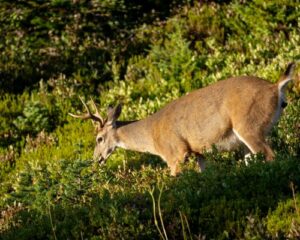 Found in Willamette Valley, West Cascades, Coast Range and Klamath Mountains, black-tailed deer stand out from other deer due to their triangular tails. As the name implies, the tails have either a dark brown or black top with a white underside. Mature black-tailed deer are between 100 to 200 pounds and 66 inches in length. They mainly eat different plant species, such as hazel, lichens, western redcedar, Douglas-fir, red alder, blackberry and more. Black-tailed deer are often seen in grasslands and parklands but can be found in more urban areas too.
Found in Willamette Valley, West Cascades, Coast Range and Klamath Mountains, black-tailed deer stand out from other deer due to their triangular tails. As the name implies, the tails have either a dark brown or black top with a white underside. Mature black-tailed deer are between 100 to 200 pounds and 66 inches in length. They mainly eat different plant species, such as hazel, lichens, western redcedar, Douglas-fir, red alder, blackberry and more. Black-tailed deer are often seen in grasslands and parklands but can be found in more urban areas too.
6. Mountain Lion
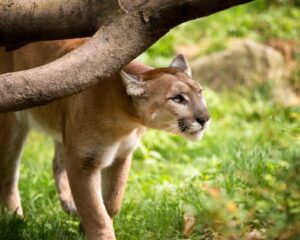 Mountain lions are mostly found in the western part of the state, but you can find them throughout Oregon. They tend to be limited east of the Cascade Range because of the Ochoco, Blue and Wallowa Mountains. Mountain lions are Oregon’s largest feline, weighing between 110 to 180 pounds and reaching lengths of 3.5 to 5.5 long. They mostly feed on mammals like deer. You can find mountain lions in almost every type of habitat, but they most often make their homes in dense vegetation in remote forested areas, especially during the winter months.
Mountain lions are mostly found in the western part of the state, but you can find them throughout Oregon. They tend to be limited east of the Cascade Range because of the Ochoco, Blue and Wallowa Mountains. Mountain lions are Oregon’s largest feline, weighing between 110 to 180 pounds and reaching lengths of 3.5 to 5.5 long. They mostly feed on mammals like deer. You can find mountain lions in almost every type of habitat, but they most often make their homes in dense vegetation in remote forested areas, especially during the winter months.
7. Pileated Woodpecker
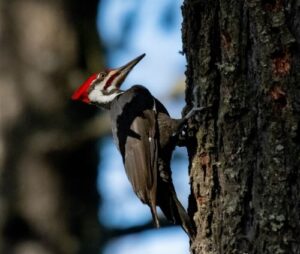 The pileated woodpecker is one of the most striking birds in the forest, thanks to its mostly black color with bold white stripes down the neck and bright red crest on top. Pileated woodpeckers can be found in the West and East Cascades, Coast Range, Willamette Valley, Klamath Mountains, Columbia Plateau and Blue Mountains. Adults are almost as large as crows. They weigh around 9 to 12 ounces and average 16 to 19 inches in length. Their wingspan is between 26 to 29.5 inches.
The pileated woodpecker is one of the most striking birds in the forest, thanks to its mostly black color with bold white stripes down the neck and bright red crest on top. Pileated woodpeckers can be found in the West and East Cascades, Coast Range, Willamette Valley, Klamath Mountains, Columbia Plateau and Blue Mountains. Adults are almost as large as crows. They weigh around 9 to 12 ounces and average 16 to 19 inches in length. Their wingspan is between 26 to 29.5 inches.
They mainly eat insects like beetles, termites and carpenter ants, though they may also eat nuts, fruits, berries and seeds. Pileated woodpeckers like to make large trees in their homes, usually ones that are about two to three feet in diameter.
8. Bobcat
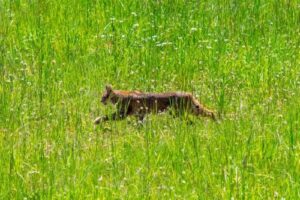 Bobcats are found all throughout Oregon’s forests. Females are much smaller than males, but typically bobcats weigh 16 to 28 pounds. Females range from 17 to 23 inches tall, and males from 25 to 41 inches. They hunt on hares and rabbits primarily, but will also eat birds and small mammals like mountain beavers and mice. Humans are actually the biggest threat to bobcats right now due to forest habitat conversion.
Bobcats are found all throughout Oregon’s forests. Females are much smaller than males, but typically bobcats weigh 16 to 28 pounds. Females range from 17 to 23 inches tall, and males from 25 to 41 inches. They hunt on hares and rabbits primarily, but will also eat birds and small mammals like mountain beavers and mice. Humans are actually the biggest threat to bobcats right now due to forest habitat conversion.
When you visit one of Oregon’s forests, you are bound to see some Oregon wildlife! Just remember to treat the forests and animals living in them respectfully. If you spot animals in their wild habitat, do not approach. Many wild animals can be dangerous if they feel provoked or threatened, so take safety precautions.
As you explore all that Oregon forests have to offer, you can also be proactive in helping protect our wildlife. You can respect their habitats while you are in the forests. Professional foresters are careful to ensure diverse habitats exist for all of Oregon’s wildlife.
If you are interested in getting more involved in keeping our Oregon wildlife and forests healthy, we encourage you to learn more about Oregon Forests Forever. Sign up to receive email updates and more information on how you get involved.